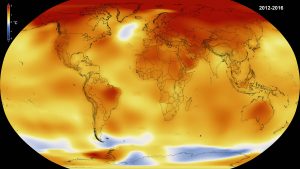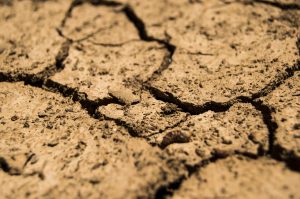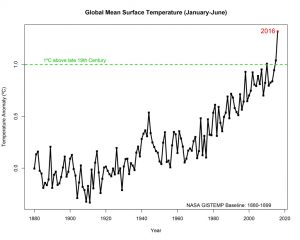10 August 2017
WASHINGTON D.C. – It is “extremely unlikely” 2014, 2015 and 2016 would have been the warmest consecutive years on record without the influence of human-caused climate change, according to the authors of a new study.
Temperature records were first broken in 2014, when that year became the hottest year since global temperature records began in 1880. These temperatures were then surpassed in 2015 and 2016, making last year the hottest year ever recorded. In 2016, the average global temperature across land and ocean surface areas was 0.94 degrees Celsius (1.69 degrees Fahrenheit) above the 20th century average of 13.9 degrees Celsius (57.0 degrees Fahrenheit), according to NOAA.

A screenshot from an animation of global temperatures since 1880. Scientists at NASA’s Goddard Institute for Space Studies (GISS) have found that Earth’s average surface temperature has risen about 1.1 degrees Celsius (2.0 degrees Fahrenheit) since the late-19th century. Credit: NASA / Scientific Visualization Studio
Combining historical temperature data and state-of-the-art climate model simulations, the new study finds the likelihood of experiencing consecutive record-breaking global temperatures from 2014 to 2016 without the effects of human-caused climate change is no greater than 0.03 percent and the likelihood of three consecutive record-breaking years happening any time since 2000 is no more than 0.7 percent. When anthropogenic warming is considered, the likelihood of three consecutive record-breaking years happening any time since 2000 rises to as high as 50 percent, according to the new study.
That means human-caused climate change is very likely to blame for the three consecutive record-hot years, according to the new study accepted for publication in Geophysical Research Letters, a journal of the American Geophysical Union.
“With climate change, this is the kind of thing we would expect to see. And without climate change, we really would not expect to see it,” said Michael Mann, a climate scientist at Pennsylvania State University in State College, Pennsylvania, and lead author of the new study.
A warming planet

Rising global temperatures are linked to more extreme weather events, such as heat waves, floods, and droughts. Credit: Luis Iranzo Navarro-Olivares
Greenhouse gases, like carbon dioxide and methane, accumulate in the atmosphere and trap heat that would otherwise escape into space. Excess greenhouse gases from industrial activities, like burning fossil fuels, are trapping additional heat in the atmosphere, causing the earth’s temperatures to rise. The average surface temperature of the planet has risen about 1.1 degrees Celsius (2.0 degrees Fahrenheit) since the late 19th century, and the past 35 years have seen a majority of the warming, with 16 of the 17 warmest years on record occurring since 2001, according to NASA.
Scientists are now trying to characterize the relationship between yearly record high temperatures and human-caused global warming.
In response to the past three years’ record-breaking temperatures, authors of the new study calculated the likelihood of observing a three-year streak of record high temperatures since yearly global temperature records began in the late 19th century and the likelihood of seeing such a streak since 2000, when much of the warming has been observed. The study’s authors determined how likely this kind of event was to happen both with and without the influence of human-caused warming.
The new study considers that each year is not independent of the ones coming before and after it, in contrast to previous estimates that assumed individual years are statistically independent from each other. There are both natural and human events that make temperature changes cluster together, such as climate patterns like El Niño, the solar cycle and volcanic eruptions, according to Mann.
When this dependency is taken into account, the likelihood of these three consecutive record-breaking years occurring since 1880 is about 0.03 percent in the absence of human-caused climate change. When the long-term warming trend from human-caused climate change is considered, the likelihood of 2014-2016 being the hottest consecutive years on record since 1880 rises to between 1 and 3 percent, according to the new study.
The probability that this series of record-breaking years would be observed at some point since 2000 is less than 0.7 percent without the influence of human-caused climate change, but between 30 and 50 percent when the influence of human-caused climate change is considered, the new study finds.

A graph of the global mean surface temperature for the six-month period of January through June of each year from 1880-2016. The numbers are the differences from the pre-industrial era, calculated as the average mean surface temperature of 1880-1899.
Credit: NASA / GISS
If human-caused climate change is not considered, the warming observed in 2016 would have about a 1-in-a-million chance of occurring, compared with a nearly 1-in-3 chance when anthropogenic warming is taken into account, according to the study.
The results make it difficult to ignore the role human-caused climate change is having on temperatures around the world, according to Mann. Rising global temperatures are linked to more extreme weather events, such as heat waves, floods, and droughts, which can harm humans, animals, agriculture and natural resources, he said.
“The things that are likely to impact us most about climate change aren’t the averages, they’re the extremes,” Mann said. “Whether it’s extreme droughts, or extreme floods, or extreme heat waves, when it comes to climate change impacts … a lot of the most impactful climate related events are extreme events. The events are being made more frequent and more extreme by human-caused climate change.”
###
The American Geophysical Union is dedicated to advancing the Earth and space sciences for the benefit of humanity through its scholarly publications, conferences, and outreach programs. AGU is a not-for-profit, professional, scientific organization representing 60,000 members in 137 countries. Join the conversation on Facebook, Twitter, YouTube, and our other social media channels.
*****
Notes for Journalists
This research article is open access for 30 days. A PDF copy of the article can be downloaded at the following link: http://onlinelibrary.wiley.com/doi/10.1002/2017GL074056/pdf
Journalists and PIOs may also order a copy of the final paper by emailing a request to Kelsey Simpkins at [email protected]. Please provide your name, the name of your publication, and your phone number.
Neither the paper nor this press release is under embargo.
“Record Temperature Streak Bears Anthropogenic Fingerprint”
Authors:
Michael E. Mann: Department of Meteorology, Pennsylvania State University, Pennsylvania, U.S.A.;
Sonya K. Miller: Department of Meteorology, Pennsylvania State University, Pennsylvania, U.S.A.;
Stefan Rahmstorf: Earth System Analysis, Potsdam Institute for Climate Impact Research, Potsdam, Germany;
Byron A. Steinman: Department of Earth and Environmental Sciences and Large Lakes Observatory, University of Minnesota Duluth, Duluth, Minnesota, U.S.A.;
Martin Tingley: Departments of Meteorology and Statistics, Pennsylvania State University, Pennsylvania, U.S.A.
Contact information for the authors:
Michael E. Mann: [email protected], +1 (814) 863-4075
Kelsey Simpkins
+1 (202) 777-7446
[email protected]